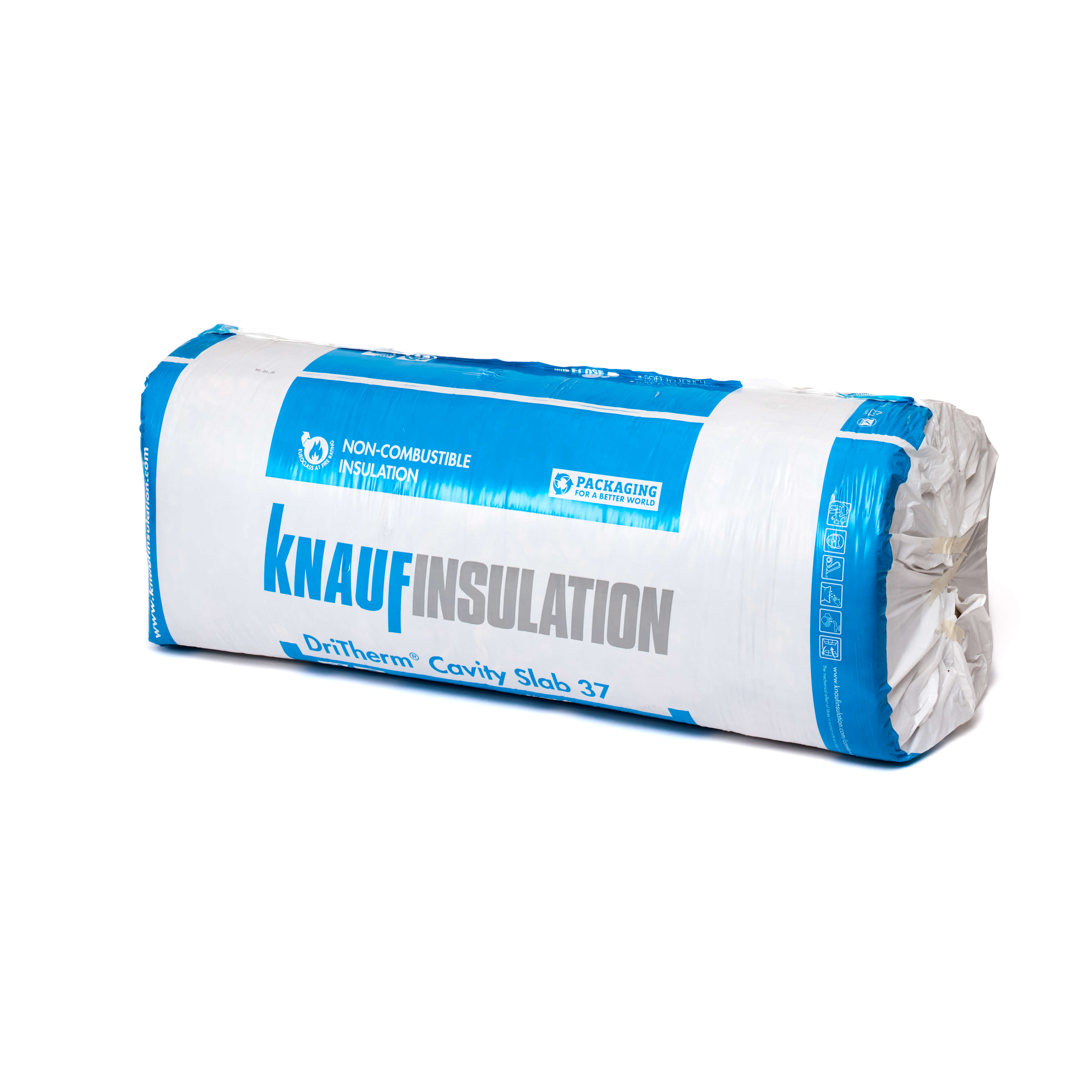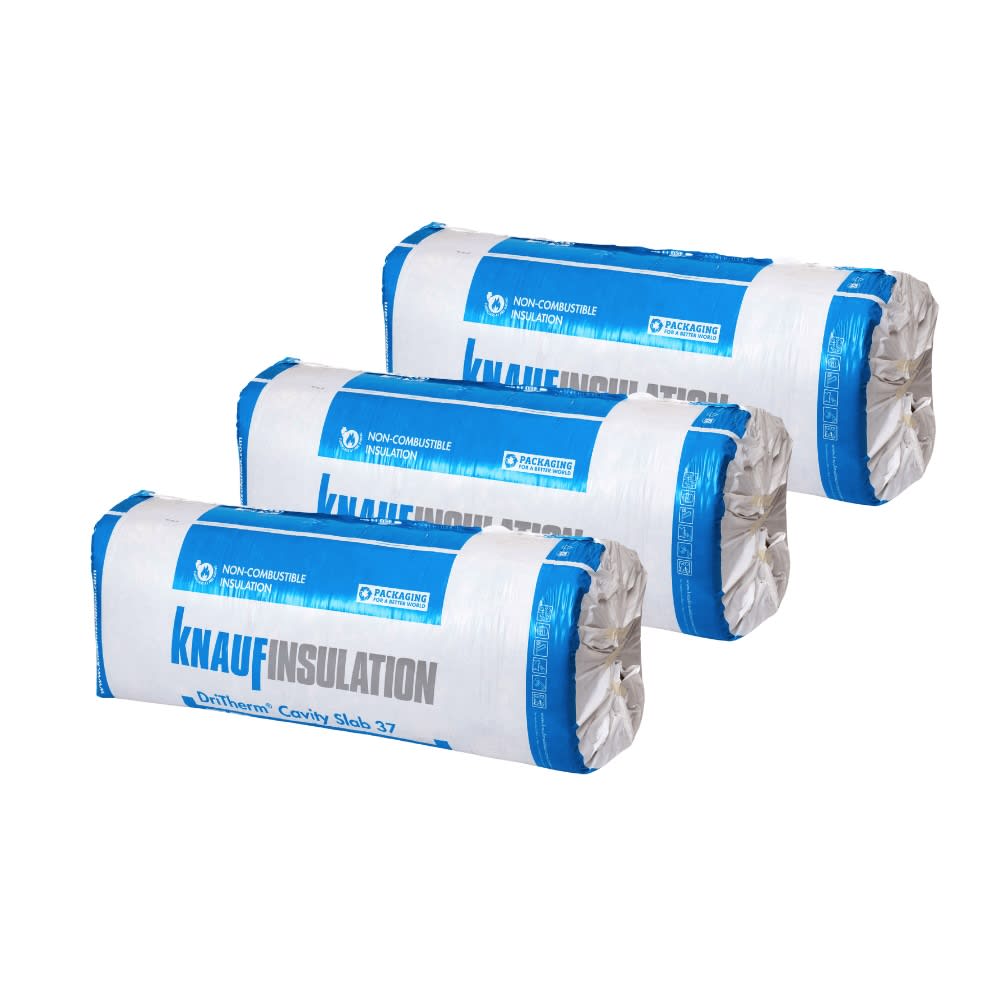Knauf DriTherm 37 Cavity Slabs
(8 Products)DriTherm 37 Standard Cavity Slabs are non-combustible glass mineral wool insulation boards treated with a water-repellent additive. The name 'DriTherm 37' reflects both its moisture resistance ("Dri") and its thermal conductivity of 0.037 W/mK ("37"). While slightly less thermally efficient than DriTherm 32, DriTherm 37 remains suitable for use in buildings up to 12 metres in height, with a Euroclass A1 fire rating.
What Is DriTherm 37?
DriTherm 37 Cavity Slabs are specifically designed for full-fill cavity wall applications. Made from glass mineral wool, they sit neatly between wall ties, making installation quick and straightforward with minimal trimming required.
Each slab is treated with a water-repellent agent to help resist moisture and maintain its shape and performance over time. Because the material is non-hygroscopic, it doesn’t absorb water or support mould or bacterial growth, something that’s especially useful in maintaining healthy indoor air and avoiding damp issues in walls.
DriTherm 37 has a declared thermal conductivity of 0.037 W/mK, so a relatively thin layer is enough to meet most cavity-wall U-value targets. In practice that means less heat slipping through the masonry and steadier indoor temperatures, without heavy reliance on heating systems.
Each slab is semi-rigid. Push it into the cavity, and the edges spring lightly against the brick or block, locking the wool in place and sealing the full depth of the void. Because the material holds its line, there are no gaps where cold air can creep in or where a thermal bridge could develop.
DriTherm 37 is also classified as Euroclass A1 for fire performance, the highest rating available under the European classification system. This confirms that the material is non-combustible and suitable for use in applications where fire safety is a design priority.
The slabs are manufactured using a high proportion of recycled glass and can be fully recycled at the end of their use, making them a better long-term choice for both the home and the environment.
Applications
Knauf Dritherm Cavity Slab 37 is purposed for use in masonry cavity external walls where a full-fill insulation solution is required.
A masonry cavity wall is made up of two leaves (or skins); an inner leaf and an outer leaf. The "cavity" is simply the gap between these two masonry walls.
DriTherm cavity slabs are considered to be an effective thermal insulation solution for buildings up to 12m high and in multi-storey applications up to 25m high.
Benefits
- Non-combustible full-fill insulation eradicates the need for cavity barriers.
- The slabs are 455mm wide to suit standard vertical wall tie spacing, ensuring a closed joint with adjacent slabs.
- Compatible with standard vertical wall ties, banishing the need for retaining discs.
- Superior environmental sustainability/low environmental impact.
- Made from up to 80% recycled glass, minimising the need for mineral raw materials.
- Rigid nature ensures that they do not sag or droop over time.
Specifications
- Suitable for external masonry cavity walls
- Non-combustible A1 Euroclass Reaction to Fire classification - minimising the risk of fire spreading throughout the cavity
- 0.037 W/mK thermal conductivity - excellent thermal performance
- Water repellent
- Rigid and compact
- Zero Global Warming Potential (GWP)
- Zero Ozone Depletion Potential (ODP)
Certifications
- Manufactured in accordance with BS EN 13162, ISO 50001 Energy Management Systems.
- BBA certified - 95/3212 - approved for use in structures up to 12m in height in any exposure zone, as well as in multi-storey applications up to 25m in height.
Installation Considerations
- Cavity Cleanliness: Before installation, ensure the cavity is free from mortar droppings, debris, and other obstructions. A clean cavity ensures proper fitting and helps avoid performance issues.
- Wall Tie Spacing: DriTherm 37 Cavity Slabs are designed to fit snugly between standard wall ties. Ensure that wall ties are correctly positioned, clean, and placed to allow for a seamless, secure fit of the insulation.
- Friction Fit: These slabs are semi-rigid and designed to fit tightly between the wall ties without gaps. They should be friction-fit for full coverage and to prevent air leakage.
- Adequate Coverage: Ensure that slabs fill the cavity completely and are installed in continuous layers. Stagger the joints between courses to avoid thermal bridges and to maintain consistent insulation performance.
- Protection During Storage and Installation: Although the slabs are water-repellent, they should be protected from excessive moisture during storage and installation. Store them in a dry, covered area and ensure they are kept off the ground.
Frequently Asked Knauf DriTherm 37 Questions
Are DriTherm 37 Cavity Slabs Waterproof?
Although not entirely waterproof, Dritherm cavity slabs are non-hygroscopic and are therefore approved to use in all exposure zones, including very severe areas, as they will not absorb moisture.
Another welcome benefit of the water-resistant binder used in Knauf slabs is that it eliminates the chance of rot, vermin, or fungus.
Are DriTherm 37 Cavity Slabs Environmentally Friendly?
Yes, they are environmentally friendly as they are made from recycled glass and are fully recyclable. This aligns with sustainable building practices.
What Is The ECOSE Technology Used in Dritherm 37 Products?
Knauf’s unique ECOSE technology; is a bio-based binder that contains no added formaldehyde or phenol, meaning the resulting slabs create much lower levels of dust than other slabs and are soft to the touch, as well as easier to handle.
Aesthetically speaking, the bio-binder creates a natural brown colour that is distinct from the typical yellow colour of insulation.
Can DriTherm 37 Cavity Slabs Be Used In Any Type of Building?
They are suitable for a wide range of buildings, including residential and commercial properties. However, it's always best to consult with a building professional to ensure they are appropriate for your specific project.





